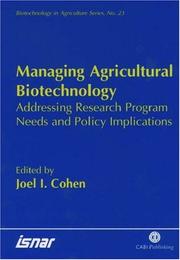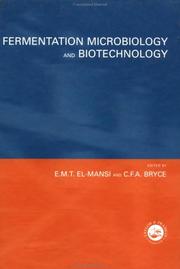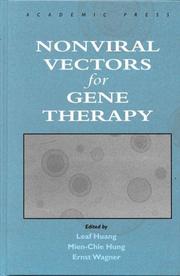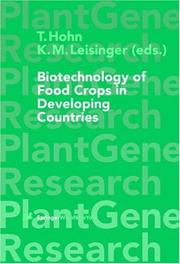| Listing 1 - 6 of 6 |
Sort by
|
Book
ISBN: 9251043698 Year: 1999 Publisher: Rome : FAO,
Abstract | Keywords | Export | Availability | Bookmark
 Loading...
Loading...Choose an application
- Reference Manager
- EndNote
- RefWorks (Direct export to RefWorks)
Biotechnologie --- Biotechnology --- Génie génétique --- genetic engineering --- Terminologie --- terminology --- 66.098 <031> --- 575.08:577.21 --- Genetic engineering --- Designed genetic change --- Engineering, Genetic --- Gene splicing --- Genetic intervention --- Genetic surgery --- Genetic recombination --- Transgenic organisms --- Chemical engineering --- Biological processes. Biotechnology--Encyclopedieën. Lexica --- Genetic engineering, genetic manipulation, recombinant DNA --- 575.08:577.21 Genetic engineering, genetic manipulation, recombinant DNA --- 66.098 <031> Biological processes. Biotechnology--Encyclopedieën. Lexica

ISBN: 0851994008 Year: 1999 Publisher: Wallingford CABI
Abstract | Keywords | Export | Availability | Bookmark
 Loading...
Loading...Choose an application
- Reference Manager
- EndNote
- RefWorks (Direct export to RefWorks)
66.098 --- 575.08:577.21 --- 63.001.5 --- Biological processes. Biotechnology --- Genetic engineering, genetic manipulation, recombinant DNA --- Agricultural research --- Agricultural biotechnology --- Management. --- 63.001.5 Agricultural research --- 575.08:577.21 Genetic engineering, genetic manipulation, recombinant DNA --- 66.098 Biological processes. Biotechnology --- Agro-biotechnology --- Biotechnology --- Management

ISBN: 0748407332 9780748407330 Year: 1999 Publisher: London : Taylor & Francis,
Abstract | Keywords | Export | Availability | Bookmark
 Loading...
Loading...Choose an application
- Reference Manager
- EndNote
- RefWorks (Direct export to RefWorks)
663.1 --- PID regelaars --- batch processen --- biologie --- biosensoren --- biotechnologie --- chemische technologie --- continue processen --- fermentatie --- fermentoren --- fuzzy control --- industriële microbiologie --- kinetica --- microbiologie --- modellen --- ontwerpen --- procesbeheersing --- procescontrole --- rDNA recombinant DNA --- regeltechniek --- voedingsmiddelen --- voedingsmiddelenmicrobiologie --- voedingsmiddelentechnologie --- Fermentation --- Microbial biotechnology --- Microorganisms --- Biotechnology --- Industrial microbiology --- Biotechnological microorganisms --- Ferments --- Biochemical engineering --- Chemistry --- Microbiological synthesis --- Leavening agents --- Microbiology. --- Biosensors --- Fermentation apparatus --- Process control --- Reaction kinetics
Book
ISBN: 9053525610 Year: 1999 Publisher: Amsterdam Boom
Abstract | Keywords | Export | Availability | Bookmark
 Loading...
Loading...Choose an application
- Reference Manager
- EndNote
- RefWorks (Direct export to RefWorks)
Dit boek is uitgekomen ter gelegenheid van de zesde 'Anatomische Les'. Een medische publiekslezing, uitgesproken door de Engelse geneticus prof. dr. Peter Goodfellow op 12 november 1999. In het boek beschrijft een twintigtal prominente wetenschappers in een serie van artikelen de stand van zaken met betrekking tot de farmacogenomie, de ontwikkeling van medicijnen toegesneden op het 'genetisch paspoort' van de patiënt. De onderzoeken op het gebied van de genetica kunnen veel publiciteit trekken, vooral wanneer ze spectaculaire gevolgen kunnen hebben: de muis met een oor op zijn rug; het schaap Dolly; de stier Herman etc.. Daarnaast is er veel onderzoek, dat in de betrekkelijke anonimiteit wordt uitgevoerd, met als doel de mogelijkheid diverse ziekten te behandelen bij de bron: het genetisch materiaal. Onderzoek naar de genetische variabiliteit van het leven en de mechanismen daarvan, hebben nieuwe inzichten en aanknopingspunten geboden voor de behandeling van ziekten. Op basis van de onderzoeken, uitgevoerd binnen het terrein van de farmacogenomie, is een nieuwe generatie van geneesmiddelen bezig te ontstaan. Veel van deze medicijnen kunnen 'op maat' gemaakt worden, toegesneden op de belangrijkste genetische eigenschappen van de patiënt. Volgens zeggen zullen deze medicijnen binnen afzienbare tijd een groot deel gaan uitmaken van het aanbod. Dat het onderzoek naar deze medicijnen geen overbodige luxe is, kan worden aangetoond met cijfers: alleen al in de VS overlijden jaarlijks ruim honderdduizend mensen door onvermoede reacties op geneesmiddelen, die ze voorgeschreven kregen door hun arts. Volgens Goodfellow is de stand van zaken bij medicijngebruik als volgt: "Als je honderd mensen een bepaald medicijn geeft, kun je grofweg stellen dat er maar dertig goed op zullen reageren en er baat bij zullen hebben; dertig andere mensen reageren er niet op en een even grote groep gebruikt het middel niet eens. Bij de resterende tien personen werkt het medicijn averechts en in het ergste geval kunnen mensen uit deze groep daardoor zelfs overlijden." In het boek wordt de lezer allereerst bekend gemaakt met het terrein van de DNAtechnologie, met de relatie tussen genetica en de geneesmiddelen en met de rol die de academische centra en de farmaceutische industrie spelen bij de ontwikkeling van geneesmiddelen op basis van DNAtechnologie. Vervolgens worden de mogelijkheden besproken van de rol die de farmacogenomie kan spelen bij specifieke ziekten, zoals vetstofwisselingsziekten en stollingsstoornissen. Het boek wordt afgesloten met de gevolgen die de farmacogenomie kan hebben voor het individu en, in het grotere verband, met de gevolgen die van invloed kunnen zijn voor de maatschappij. Natuurlijk is er aan het eind van het boek een register, met daaraan voorafgaand een glossarium met een groot aantal medische termen, die verband hebben met de genoemde onderwerpen. Het niveau van dit boek is beslist te hoog voor gebruik door de gemiddelde leerling. Voor ieder ander die zich in deze materie wil verdiepen, zeker de moeite waard.
241.63*2 --- #GBIB:Overlegcentrum Christelijke Ethiek --- Gentherapie --- Genetica --- farmacogenetica --- geneesmiddelen --- genetica (genen) --- 241.63*2 Theologische ethiek: medische ethiek: dokter; verpleegster; ziekenhuis --- Theologische ethiek: medische ethiek: dokter; verpleegster; ziekenhuis --- Thérapies géniques --- Génétique --- pharmacogénétique --- médicaments --- génétique (gènes) --- Pharmacology. Therapy --- recombinant DNA --- farmacogenomie --- farmacologie --- genetische informatie --- Thérapies géniques --- Génétique --- pharmacogénétique --- médicaments --- génétique (gènes)

ISBN: 1281050431 9786611050436 0080479774 0123584655 Year: 1999 Publisher: San Diego, CA : Academic Press,
Abstract | Keywords | Export | Availability | Bookmark
 Loading...
Loading...Choose an application
- Reference Manager
- EndNote
- RefWorks (Direct export to RefWorks)
Gene transfer within humans has been an obstacle until about 10 years ago. At that time, it was found that viral vectors were effective carriers of ""healthy genes"" into patients' cells. The problem, however, was that viral vectors proved unnecessarily harmful to humans: subjects experienced inflammatory activity and negative immunological responses to the genes. Viral vectors were also unable to meet the needs of the pharmaceutical community: they were not reproducible in large-scale proportions in cost-effective ways.
DNA-ligand interactions. --- Drug targeting. --- Gene therapy. --- Gene therapy. Genetic vectors. DNA-ligand interactions. Liposomes. Drug targeting. --- Genetic transformation. --- Genetic vectors. --- Liposomes. --- Recombination, Genetic --- Genetic Structures --- Genetic Techniques --- Investigative Techniques --- Genetic Phenomena --- Genetic Processes --- Phenomena and Processes --- Analytical, Diagnostic and Therapeutic Techniques and Equipment --- Genetic Vectors --- Gene Transfer Techniques --- Transformation, Genetic --- Medicine --- Health & Biological Sciences --- Pathology --- Gene transfer --- Transformation (Genetics) --- Drugs --- Site-specific drug delivery --- Targeting of drugs --- Phospholipid vesicles --- Binding, DNA-ligand --- DNA-ligand binding --- Interactions, DNA-ligand --- Therapy, Gene --- Cloning vectors --- Expression vectors (Genetics) --- rDNA vectors --- Recombinant DNA vectors --- Vectors, Genetic --- Targeting --- Genetic recombination --- Microbial genetics --- Nucleic acids --- Transfection --- Target organs (Anatomy) --- Bilayer lipid membranes --- Cytoplasm --- Phospholipids --- Ligand binding (Biochemistry) --- Genetic engineering --- Therapeutics --- Gene expression --- Molecular cloning --- Recombinant DNA --- Dosage forms

ISBN: 3211832408 3709173167 3709164060 Year: 1999 Publisher: Wien : Springer,
Abstract | Keywords | Export | Availability | Bookmark
 Loading...
Loading...Choose an application
- Reference Manager
- EndNote
- RefWorks (Direct export to RefWorks)
Tropical crops such as cowpea, yam, plantain, and cassava are heavily underresearched but, in addition to rice, maize, wheat, and potato, are important as primary or secondary food staples in the developing countries. The modern tools of molecular and cellular technology offer the opportunity not only to make substantial gains in knowledge of these crops, but also they overcome some of the obstacles which presently restrain both the genetic improvement and the productivity of these crops in tropical farming systems. Increased nutritional value of these crops, reduced post-harvest perishability, and lower costs of production are some of the advantages taken from biotechnology. Engineered genetic resistance would also allow to drastically reduce employment of pesticides, which at present are expensive or unavailable for farmers in developing countries and may create environmental and health hazards.In this book experts present opportunities to improve the efficiency of plant breeding programs also taking into account the ethical and sociopolitical aspects of these technologies.
Plante de culture --- Crops --- Plante transgénique --- Transgenic plants --- Méthode d'amélioration génétique --- breeding methods --- Environnement socioéconomique --- socioeconomic environment --- Ethics --- Pays en développement --- Developing countries --- 575.08:577.21 --- 633.491 --- 633.493 --- 633.1 --- Food crops --- -#ABIB:atte --- Food --- Plants, Edible --- Field crops --- Horticultural crops --- Genetic engineering, genetic manipulation, recombinant DNA --- Potato. Solanum tuberosum --- Cassava. Manioc. Manihot utilissima --- Cereals. Grain crops --- Biotechnology --- Biotechnology. --- 633.1 Cereals. Grain crops --- 633.493 Cassava. Manioc. Manihot utilissima --- 633.491 Potato. Solanum tuberosum --- 575.08:577.21 Genetic engineering, genetic manipulation, recombinant DNA --- #ABIB:atte --- Agriculture. --- Forestry. --- Forest land --- Forest lands --- Forest planting --- Forest production --- Forest sciences --- Forestation --- Forested lands --- Forestland --- Forestlands --- Forestry --- Forestry industry --- Forestry sciences --- Land, Forest --- Lands, Forest --- Silviculture --- Sylviculture --- Woodlands --- Woods (Forests) --- Agriculture --- Natural resources --- Afforestation --- Arboriculture --- Logging --- Timber --- Tree crops --- Trees --- Farming --- Husbandry --- Industrial arts --- Life sciences --- Food supply --- Land use, Rural --- Chemical engineering --- Genetic engineering
| Listing 1 - 6 of 6 |
Sort by
|

 Search
Search Feedback
Feedback About UniCat
About UniCat  Help
Help News
News